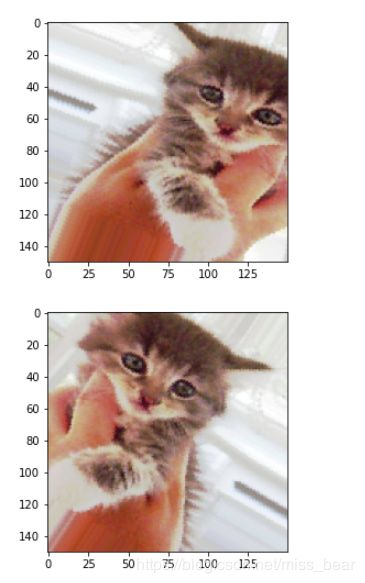猫狗数据集两阶段分类
文章目录
- 一、直接训练
- 1、导入需要的库
- 2、创建文件夹
- 3、建立网络
- 4、数据预处理
- 二、数据增强
- 三、过拟合
- 四、数据增强
一、直接训练
1、导入需要的库
import keras
keras.__version__
'2.0.6'
import os, shutil
2、创建文件夹
会在创建好的文件夹下面创建train、test、validation三个文件夹,同时这三个文件夹下面都会创建cat与dog文件夹,并拷贝猫狗图片到文件夹下面
# The path to the directory where the original
# dataset was uncompressed
#测试集
original_dataset_dir = 'datasets/kaggle/train/'
# The directory where we will
# store our smaller dataset
#创建的文件夹
base_dir = 'datasets/猫狗数据'
os.mkdir(base_dir)
# Directories for our training,
# validation and test splits
#会在猫狗数据文件夹下创建train、test、validation三个文件夹
train_dir = os.path.join(base_dir, 'train')
os.mkdir(train_dir)
validation_dir = os.path.join(base_dir, 'validation')
os.mkdir(validation_dir)
test_dir = os.path.join(base_dir, 'test')
os.mkdir(test_dir)
# Directory with our training cat pictures
#train文件夹下创建cats和dogs文件夹
train_cats_dir = os.path.join(train_dir, 'cats')
os.mkdir(train_cats_dir)
# Directory with our training dog pictures
train_dogs_dir = os.path.join(train_dir, 'dogs')
os.mkdir(train_dogs_dir)
# Directory with our validation cat pictures
#validation文件夹下创建cats和dogs文件夹
validation_cats_dir = os.path.join(validation_dir, 'cats')
os.mkdir(validation_cats_dir)
# Directory with our validation dog pictures
validation_dogs_dir = os.path.join(validation_dir, 'dogs')
os.mkdir(validation_dogs_dir)
# Directory with our validation cat pictures
#test文件夹下创建cats文件夹和dogs文件夹
test_cats_dir = os.path.join(test_dir, 'cats')
os.mkdir(test_cats_dir)
# Directory with our validation dog pictures
test_dogs_dir = os.path.join(test_dir, 'dogs')
os.mkdir(test_dogs_dir)
# Copy first 1000 cat images to train_cats_dir
#复制猫图片
fnames = ['cat.{}.jpg'.format(i) for i in range(1000)]
for fname in fnames:
src = os.path.join(original_dataset_dir, fname)
dst = os.path.join(train_cats_dir, fname)
shutil.copyfile(src, dst)
# Copy next 500 cat images to validation_cats_dir
fnames = ['cat.{}.jpg'.format(i) for i in range(1000, 1500)]
for fname in fnames:
src = os.path.join(original_dataset_dir, fname)
dst = os.path.join(validation_cats_dir, fname)
shutil.copyfile(src, dst)
# Copy next 500 cat images to test_cats_dir
fnames = ['cat.{}.jpg'.format(i) for i in range(1500, 2000)]
for fname in fnames:
src = os.path.join(original_dataset_dir, fname)
dst = os.path.join(test_cats_dir, fname)
shutil.copyfile(src, dst)
# Copy first 1000 dog images to train_dogs_dir
fnames = ['dog.{}.jpg'.format(i) for i in range(1000)]
for fname in fnames:
src = os.path.join(original_dataset_dir, fname)
dst = os.path.join(train_dogs_dir, fname)
shutil.copyfile(src, dst)
# Copy next 500 dog images to validation_dogs_dir
fnames = ['dog.{}.jpg'.format(i) for i in range(1000, 1500)]
for fname in fnames:
src = os.path.join(original_dataset_dir, fname)
dst = os.path.join(validation_dogs_dir, fname)
shutil.copyfile(src, dst)
# Copy next 500 dog images to test_dogs_dir
fnames = ['dog.{}.jpg'.format(i) for i in range(1500, 2000)]
for fname in fnames:
src = os.path.join(original_dataset_dir, fname)
dst = os.path.join(test_dogs_dir, fname)
shutil.copyfile(src, dst)
打印尺寸
print('total training cat images:', len(os.listdir(train_cats_dir)))
print('total training dog images:', len(os.listdir(train_dogs_dir)))
print('total validation cat images:', len(os.listdir(validation_cats_dir)))
print('total validation dog images:', len(os.listdir(validation_dogs_dir)))
print('total test cat images:', len(os.listdir(test_cats_dir)))
print('total test dog images:', len(os.listdir(test_dogs_dir)))
3、建立网络
#创建模型
from keras import layers
from keras import models
model = models.Sequential()
model.add(layers.Conv2D(32, (3, 3), activation='relu',
input_shape=(150, 150, 3)))
model.add(layers.MaxPooling2D((2, 2)))
model.add(layers.Conv2D(64, (3, 3), activation='relu'))
model.add(layers.MaxPooling2D((2, 2)))
model.add(layers.Conv2D(128, (3, 3), activation='relu'))
model.add(layers.MaxPooling2D((2, 2)))
model.add(layers.Conv2D(128, (3, 3), activation='relu'))
model.add(layers.MaxPooling2D((2, 2)))
model.add(layers.Flatten())
model.add(layers.Dense(512, activation='relu'))
model.add(layers.Dense(1, activation='sigmoid'))
model.summary()
from keras import optimizers
model.compile(loss='binary_crossentropy',
optimizer=optimizers.RMSprop(lr=1e-4),
metrics=['acc'])
4、数据预处理
正如您现在所知道的,在将数据输入到我们的网络之前,应该将数据格式化为经过适当预处理的浮点张量。目前,我们的数据以JPEG文件的形式保存在硬盘上,因此将其导入网络的步骤大致如下:
读取图片文件。
解码JPEG内容到RBG像素网格。
把它们转换成浮点张量。
将像素值(从0到255)缩放到[0,1]区间(如您所知,神经网络更喜欢处理小的输入值)。
from keras.preprocessing.image import ImageDataGenerator
# All images will be rescaled by 1./255
train_datagen = ImageDataGenerator(rescale=1./255)
test_datagen = ImageDataGenerator(rescale=1./255)
train_generator = train_datagen.flow_from_directory(
# 目标文件目录
train_dir,
#所有图片的size必须是150x150
target_size=(150, 150),
batch_size=20,
# Since we use binary_crossentropy loss, we need binary labels
class_mode='binary')
validation_generator = test_datagen.flow_from_directory(
validation_dir,
target_size=(150, 150),
batch_size=20,
class_mode='binary')
for data_batch, labels_batch in train_generator:
print('data batch shape:', data_batch.shape)
print('labels batch shape:', labels_batch.shape)
break
history = model.fit_generator(
train_generator,
steps_per_epoch=100,
epochs=30,
validation_data=validation_generator,
validation_steps=50)
#保存模型
model.save('cats_and_dogs_small_1.h5')
绘图
import matplotlib.pyplot as plt
acc = history.history['acc']
val_acc = history.history['val_acc']
loss = history.history['loss']
val_loss = history.history['val_loss']
epochs = range(len(acc))
plt.plot(epochs, acc, 'bo', label='Training acc')
plt.plot(epochs, val_acc, 'b', label='Validation acc')
plt.title('Training and validation accuracy')
plt.legend()
plt.figure()
plt.plot(epochs, loss, 'bo', label='Training loss')
plt.plot(epochs, val_loss, 'b', label='Validation loss')
plt.title('Training and validation loss')
plt.legend()
plt.show()
二、数据增强
过度拟合是由于可供学习的样本太少,使我们无法训练一个模型来泛化到新的数据。给定无限的数据,我们的模型将暴露于手头数据分布的每一个可能方面:我们永远不会过度拟合。数据增强采用的方法是从现有的训练样本中生成更多的训练数据,方法是通过一系列随机变换来“增强”样本,从而产生看上去可信的图像。我们的目标是在训练时,我们的模型不会两次看到完全相同的图像。这有助于将模型暴露于数据的更多方面,并更好地泛化。
datagen = ImageDataGenerator(
rotation_range=40,
width_shift_range=0.2,
height_shift_range=0.2,
shear_range=0.2,
zoom_range=0.2,
horizontal_flip=True,
fill_mode='nearest')
这些只是可用的一些选项(有关更多信息,请参见Keras文档)。让我们快速浏览一下我们刚才写的内容:
rotation_range 是一个值,以度为单位(0-180),在该范围内随机旋转图片。
width_shift和height_shift是可以在其中垂直或水平随机转换图片的范围(占总宽度或高度的一部分)。
shear_range 用于随机应用剪切变换。
zoom_range 用于随机放大图片。
horizontal_flip 用于随机水平翻转图像的一半-在没有水平不对称性假设的情况下(例如,真实世界的图片)相关。
fill_mode 是用于填充新创建的像素的策略,这些像素可以在旋转或宽度/高度偏移后出现。
让我们看一下我们的增强图像
# This is module with image preprocessing utilities
from keras.preprocessing import image
fnames = [os.path.join(train_cats_dir, fname) for fname in os.listdir(train_cats_dir)]
# We pick one image to "augment"
img_path = fnames[3]
# Read the image and resize it
img = image.load_img(img_path, target_size=(150, 150))
# Convert it to a Numpy array with shape (150, 150, 3)
x = image.img_to_array(img)
# Reshape it to (1, 150, 150, 3)
x = x.reshape((1,) + x.shape)
# The .flow() command below generates batches of randomly transformed images.
# It will loop indefinitely, so we need to `break` the loop at some point!
i = 0
for batch in datagen.flow(x, batch_size=1):
plt.figure(i)
imgplot = plt.imshow(image.array_to_img(batch[0]))
i += 1
if i % 4 == 0:
break
plt.show()


如果我们使用此数据扩充配置训练新网络,则我们的网络将永远不会看到两次相同的输入。但是,它看到的输入仍然是高度相互关联的,因为它们来自少量的原始图像-我们无法产生新信息,我们只能重新混合现有信息。因此,这可能不足以完全摆脱过度拟合的问题。为了进一步解决过度拟合问题,我们还将在紧密连接的分类器之前为模型添加一个Dropout层:
model = models.Sequential()
model.add(layers.Conv2D(32, (3, 3), activation='relu',
input_shape=(150, 150, 3)))
model.add(layers.MaxPooling2D((2, 2)))
model.add(layers.Conv2D(64, (3, 3), activation='relu'))
model.add(layers.MaxPooling2D((2, 2)))
model.add(layers.Conv2D(128, (3, 3), activation='relu'))
model.add(layers.MaxPooling2D((2, 2)))
model.add(layers.Conv2D(128, (3, 3), activation='relu'))
model.add(layers.MaxPooling2D((2, 2)))
model.add(layers.Flatten())
model.add(layers.Dropout(0.5))
model.add(layers.Dense(512, activation='relu'))
model.add(layers.Dense(1, activation='sigmoid'))
model.compile(loss='binary_crossentropy',
optimizer=optimizers.RMSprop(lr=1e-4),
metrics=['acc'])
train_datagen = ImageDataGenerator(
rescale=1./255,
rotation_range=40,
width_shift_range=0.2,
height_shift_range=0.2,
shear_range=0.2,
zoom_range=0.2,
horizontal_flip=True,)
# Note that the validation data should not be augmented!
test_datagen = ImageDataGenerator(rescale=1./255)
train_generator = train_datagen.flow_from_directory(
# This is the target directory
train_dir,
# All images will be resized to 150x150
target_size=(150, 150),
batch_size=32,
# Since we use binary_crossentropy loss, we need binary labels
class_mode='binary')
validation_generator = test_datagen.flow_from_directory(
validation_dir,
target_size=(150, 150),
batch_size=32,
class_mode='binary')
history = model.fit_generator(
train_generator,
steps_per_epoch=100,
epochs=100, #建议修改参数 100的话要跑很久
validation_data=validation_generator,
validation_steps=50)
保存版本2模型
model.save('cats_and_dogs_small_2.h5')
绘图
acc = history.history['acc']
val_acc = history.history['val_acc']
loss = history.history['loss']
val_loss = history.history['val_loss']
epochs = range(len(acc))
plt.plot(epochs, acc, 'bo', label='Training acc')
plt.plot(epochs, val_acc, 'b', label='Validation acc')
plt.title('Training and validation accuracy')
plt.legend()
plt.figure()
plt.plot(epochs, loss, 'bo', label='Training loss')
plt.plot(epochs, val_loss, 'b', label='Validation loss')
plt.title('Training and validation loss')
plt.legend()
plt.show()
三、过拟合
过拟合的根本的原因则是特征维度过多,导致拟合的函数完美的经过训练集,但是对新数据的预测结果则较差。
解决过拟合的方法:
(1)在神经网络模型中,可使用权值衰减的方法,即每次迭代过程中以某个小因子降低每个权值。
(2)选取合适的停止训练标准,使对机器的训练在合适的程度;
(3)保留验证数据集,对训练成果进行验证;
(4)获取额外数据进行交叉验证;
(5)正则化,即在进行目标函数或代价函数优化时,在目标函数或代价函数后面加上一个正则项,一般有L1正则与L2正则等。
四、数据增强
数据集增强主要是为了减少网络的过拟合现象,通过对训练图片进行变换可以得到泛化能力更强的网络,更好的适应应用场景。
常用的数据增强方法有:
1、旋转 | 反射变换(Rotation/reflection): 随机旋转图像一定角度; 改变图像内容的朝向;
2、翻转变换(flip): 沿着水平或者垂直方向翻转图像;
3、缩放变换(zoom): 按照一定的比例放大或者缩小图像;
4、平移变换(shift): 在图像平面上对图像以一定方式进行平移;
5、可以采用随机或人为定义的方式指定平移范围和平移步长, 沿水平或竖直方向进行平移. 改变图像内容的位置;
6、尺度变换(scale): 对图像按照指定的尺度因子, 进行放大或缩小; 或者参照SIFT特征提取思想, 利用指定的尺度因子对7、图像滤波构造尺度空间. 改变图像内容的大小或模糊程度;
8、对比度变换(contrast): 在图像的HSV颜色空间,改变饱和度S和V亮度分量,保持色调H不变. 对每个像素的S和V分9、量进行指数运算(指数因子在0.25到4之间), 增加光照变化;
10、噪声扰动(noise): 对图像的每个像素RGB进行随机扰动, 常用的噪声模式是椒盐噪声和高斯噪声;
11、颜色变化:在图像通道上添加随机扰动。
个人博客地址





